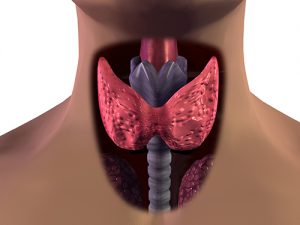 The thyroid and parathyroid are endocrine glands near the throat that secrete hormones throughout the body. The thyroid is bowtie-shaped and rests in front of the trachea (windpipe). It uses iodine from food to regulate the body’s energy. The parathyroid is a cluster of smaller glands located on the back of the thyroid. Their role is to control the amount of calcium in the blood.
The thyroid and parathyroid are endocrine glands near the throat that secrete hormones throughout the body. The thyroid is bowtie-shaped and rests in front of the trachea (windpipe). It uses iodine from food to regulate the body’s energy. The parathyroid is a cluster of smaller glands located on the back of the thyroid. Their role is to control the amount of calcium in the blood.
The most common thyroid disease is hyperthyroidism. Hyperthyroidism is defined as an overproduction of thyroid hormones, and there are several ways it can present: Graves’ disease, which is the production of too much thyroid hormone; toxic adenomas, or small nodules that develop in the thyroid gland that also produce hormones, disrupting the body’s chemical balance; subacute thyroiditis, which is inflammation of the thyroid that causes the gland to “leak” excess hormones, lasting a few weeks to a few months and hyperthyroidism developed from pituitary gland malfunctions or cancerous growths. Hypothyroidism, by contrast, is the underproduction of thyroid hormones. It is caused by certain drugs, autoimmune disorders and removal of the thyroid.
The primary disease of the parathyroid glands, like with the thyroid, is overproduction of hormones. This is called hyperparathyroidism. The most common way this occurs is the development of benign tumors in one or more of the parathyroid glands. The tumors produce hormones too, which causes calcium imbalances in the body. The parathyroid glands can also grow cancerous tumors, but this is very rare.
